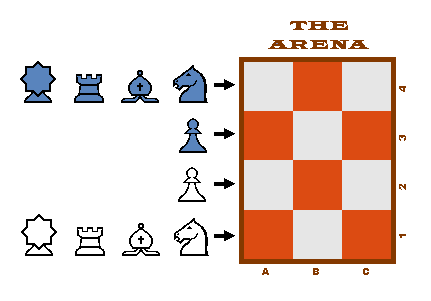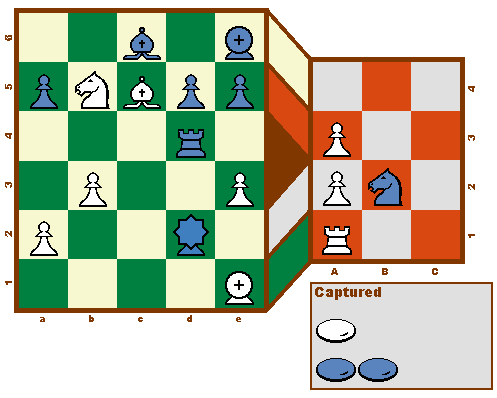Arena Chess 42
The game board is split up into two areas: the Field, and the Arena. All pieces start play on the Field, and when captured, are transported into the Arena. Whereas the Field may be seen as a civilized place, where capture is simple removal to another board, the Arena is a brutal place where captures result in pieces being removed permanently from the game. The intent here was to create a strategic tension between keeping one's powerful pieces on the Field in order to checkmate the opponent's Royal piece, and wanting powerful pieces in the Arena to eliminate enough of the opponent's pieces to win the game (see rules below).Note, there is already a game called Arena Chess that was an entry in the 32-Turn contest. My apologies to the author of that game, but I really couldn't think of a better name to call this game.

  Royal Wazir | Moves one square either forward, backward, or sideways. This is the Royal piece and may not move into check. A player may win by checkmating his opponent's Royal Wazir. |
Guard | Moves to any adjacent square. |
Short-Bishop | Moves one or two squares diagonally. May not leap over other pieces. Equivalent to a orthodox chess Bishop that is limited to moving two squares. |
Knight | Moves like the orthodox chess Knight. |
Short-Rook | Moves one or two squares either forward, backward, or sideways. May not leap over other pieces. Equivalent to a orthodox chess Rook that is limited to moving two squares. |
Pawn | Moves like the orthodox chess pawn, except that it may not make an initial two-square move. Promotes on the 2nd last rank to a Guard. |
Rules
orthodox chess rules, except as follows:- There is no castling or two-square initial pawn move.
- Pawns promote when moving to the 2nd last rank. They must promote to a Guard.
- When a piece is captured on the Field, it is transported to the Arena. White non-pawn pieces are placed on the first row, white pawns are placed on the second row. Black non-pawn pieces are placed on the 4th row, and black pawns are placed on the 3rd row. The captured piece is placed on the first empty square, starting from the leftmost square in the row. If there are no empty squares in the row, the captured piece is eliminated.

- Pieces in the Arena move just as they do in the Field. However, when a piece is captured in the Arena, it is eliminated (ie. removed from the game). Pawns in the Arena promote on the last rank, and must promote to a Guard.
- On a player's turn, they may either make a move on the Field, or a move on the Arena.
- The goal of the game is to either checkmate your opponent's Royal Wazir, or eliminate four of your opponent's pieces.
Zillions of Games
There is an implementation of Arena Chess 42 for Zillions of games. You can download it here:
Sample Game
The following is a game played between Peter Aronson and Tony Quintanilla in September 2001:1. Pawn d2 - d3 Pawn c5 - c4 2. Pawn d3 x c4 Pawn c4 - A3 Pawn b5 x c4 Pawn c4 - A23. Pawn c2 - c3 Knight b6 - a4 4. Pawn b2 - b3 Knight a4 x c3 Pawn c3 - B2
5. Pawn B2 x A3 Knight c3 x d1 Guard d1 - A1 6. Royal-Wazir e1 x d1 Knight d1 - A4 Pawn c4 - c3
7. Knight b1 x c3 Pawn c3 - B3 Pawn B3 - B2 8. Guard A1 x B2 Knight A4 x B2
9. Short-Rook a1 - b1 Short-Rook a6 - b6 10. Pawn e2 - e3 Short-Rook b6 - b5
11. Short-Bishop c1 - a3 Short-Rook b5 - b4 12. Royal-Wazir d1 - e1 Short-Rook b4 - d4
13. Short-Rook b1 - d1 Guard d6 - c5 14. Short-Rook d1 - d2 Guard c5 - c4
15. Short-Bishop a3 - c5 Guard c4 - d3 16. Knight c3 - b5 Guard d3 x d2 Short-Rook d2 - A1

Analysis using Zillions shows that if white had captured black's Guard with his Short-Rook on turn 16, the game could have gone on considerably longer.
Thanks to Peter and Tony for trying out the game, and to Peter for sending me the saved game with his comments.
For those interested in using Zillions of Games to view the above game, here is the Zillions Saved Game (zsg) file:
Here is a Zillions Saved Game (zsg) file for the above sample game, except that I let Zillions take over (ie. play against itself) on turn 16. The game went to turn 35 with black winning by making 4 captures.
Written by David Howe.
WWW page created: 25 August 2001.